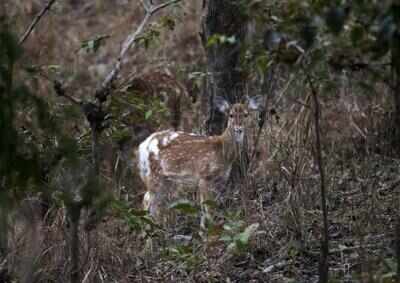
Nagpur: After an albino sambar was recorded in Navegaon-Nagzira Tiger Reserve (NNTR) last month, a deer with coat variation having white patches on its body was sighted by a tourist on Sunday morning at Sillari in Pench Tiger Reserve.
The picture clicked by wildlife photographer Ajit Kulkarni shows the deer’s mouth is white and similar big spots on the body.
“It was the lone deer with spots among the flock. We were curious and thought it was an albino deer but it needs to be verified by experts,” said Kulkarni.
However, veterinarian and forensic expert from Karnataka Dr Prayag HS said, ‘The deer cannot be termed albino.”
Dr Vinod Dhoot with Wildlife Research Training Centre (WRTC), Gorewada Rescue Centre, said, “The white spots are due to some mineral or vitamin deficiency. The discoloration of hair may be due to deficiency of copper since the mineral plays an important role in melanin formation.”
Wildlife vet Dr Bahar Baviskar said, “It looks to be a case of vitiligo or piebaldism. There should be long-term monitoring of such cases. Further investigation using molecular test will help in exact diagnosis. It may be case of piebaldism or vitiligo. In vitiligo, white patches will keep changing on body parts and in piebaldism the white patches will be static at one place.”
Dr Baviskar added, “There are many disease conditions in the free-ranging wildlife which need detailed study. These are acquired skin disorders characterized by white and depigmented patches. It is due to disappearance of functioning melanocytes and loss of melanin in the epidermis.”
Wildlife biologist with Wildlife Conservation Trust (WCT) Aditya Joshi says, “It is case of coat variation. If a large portion of the body is covered with such patches, they are called as piebald. But in case of the deer, these patches are small. It is a variation occurring due to unpigmented spots over the coloured coat. It occurs in several other species.”
The picture clicked by wildlife photographer Ajit Kulkarni shows the deer’s mouth is white and similar big spots on the body.
“It was the lone deer with spots among the flock. We were curious and thought it was an albino deer but it needs to be verified by experts,” said Kulkarni.
However, veterinarian and forensic expert from Karnataka Dr Prayag HS said, ‘The deer cannot be termed albino.”
Dr Vinod Dhoot with Wildlife Research Training Centre (WRTC), Gorewada Rescue Centre, said, “The white spots are due to some mineral or vitamin deficiency. The discoloration of hair may be due to deficiency of copper since the mineral plays an important role in melanin formation.”
Wildlife vet Dr Bahar Baviskar said, “It looks to be a case of vitiligo or piebaldism. There should be long-term monitoring of such cases. Further investigation using molecular test will help in exact diagnosis. It may be case of piebaldism or vitiligo. In vitiligo, white patches will keep changing on body parts and in piebaldism the white patches will be static at one place.”
Dr Baviskar added, “There are many disease conditions in the free-ranging wildlife which need detailed study. These are acquired skin disorders characterized by white and depigmented patches. It is due to disappearance of functioning melanocytes and loss of melanin in the epidermis.”
Wildlife biologist with Wildlife Conservation Trust (WCT) Aditya Joshi says, “It is case of coat variation. If a large portion of the body is covered with such patches, they are called as piebald. But in case of the deer, these patches are small. It is a variation occurring due to unpigmented spots over the coloured coat. It occurs in several other species.”
Trending Topics
LATEST VIDEOS
More from TOI
Navbharat Times
Featured Today in Travel
Get the app







